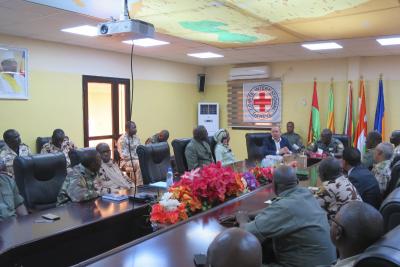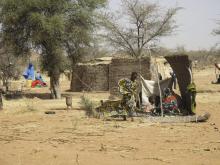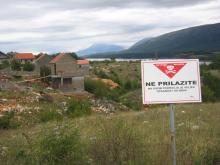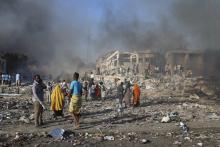Basic international humanitarian law (IHL) rules applicable to this situation:
Parties to the conflict must distinguish between civilians and combatants, and between civilian objects and military objects. Attacks may only be directed against combatants or military objectives (principle of distinction).
It is prohibited to launch indiscriminate attacks as well as attacks which may be expected to cause incidental loss of civilian life, injury to civilians, damage to civilian objects, or a combination thereof, which would be excessive in relation to the concrete and direct military advantage anticipated (principle of proportionality).
In conducting military operations, constant care must be taken to spare the civilian population, civilians and civilian objects. All feasible precautions must be taken to avoid, and in any event to minimize, incidental loss of civilian life, injury to civilians and damage to civilian objects including when choosing means and methods of warfare (principle of precautions in attack).
The case in brief
The G5 Sahel* was founded in 2014 as a regional, intergovernmental organization to promote development and security in its member countries, i.e., Burkina Faso, Chad, Mali, Mauritania and Niger. In 2017 the G5 Sahel launched a Joint Force to fight against common security threats in west Africa. Following this development, in its Resolution 2391 (2017) the United Nations Security Council (UNSC) called upon G5 Sahel states to establish a Compliance Framework to prevent and address potential violations of international human rights law (IHRL) and international humanitarian law (IHL) committed during military operations. In 2019 the G5 Sahel Joint Force collaborated with the Office of the United Nations High Commissioner for Human Rights (OHCHR), the European Union (EU) and CIVIC, a non-governmental organization, to establish a Civilian Casualties Identification, Tracking, and Analysis Cell (CITAC or MISAD in French). The aim of CITAC was to analyze the impact of the Joint Force’s operations on civilians, to enhance its tactics and to foster dialogue with populations to prevent and address casualties and damages. The CITAC was officially launched in 2021, and in the same year allowed the Joint Force to record allegations of sexual violence by members of its troops, identify the perpetrators, and return them for prosecution in their home country.
* Since the end of 2023 G5 Sahel has been dismantled: after Mali’s decision to leave the alliance in 2022, Burkina Faso and Niger followed in 2023, and Chad and Mauritania agreed to its dissolution.
IHL compliance highlights
- On 27 June 2020, the commander of the G5 Sahel Joint Force, General Oumarou Namata, approved the establishment of the CITAC within the force.
- On 4 March 2021, following the G5 Sahel’s awareness of the rape allegations by troop members, action was taken by the Commander of the central zone, which included investigations, sanctions against the perpetrators, and immediate assistance to victims.
Case prepared by Benedetta Panagia, Maria Chiara Giaquinto, Nour Taki and Karina Mele, LL.M. students at Roma Tre University, under the supervision of Professor Giulio Bartolini (IHL Professor) and Laura Di Gianfrancesco (Research assistant), Roma Tre University IHL Legal Clinic.
A. PROTECTING CIVILIANS IN WAR WITH THE G5 SAHEL JOINT MILITARY FORCE: FROM THEORY TO PRACTICE
[Source: European Union, Protecting civilians in war with the G5 Sahel joint military force: from theory to practice, 19 August 2021, available at
https://capacity4dev.europa.eu/articles/protecting-civilians-war-g5-sah…;
About the G5 Sahel Compliance Framework project
For the protection of civilian populations, it is crucial that troops deployed in war zones respect International Human Rights Law (IHRL), International Humanitarian Law (IHL) and International Refugee Law (IRL). This is undertaken in the Sahel by the joint military force, created in 2017, by five countries in the region called the Force Conjointe du G5 Sahel (FC-G5S). The collaborative efforts of these countries to combat terrorism, transnational organized crime and human trafficking are supported by concrete and tailor-made measures and mechanisms which protect civilians with the support of the UN and the EU.
Furthermore, the Technical Arrangement signed between the G5 Sahel, the EU, and the UN in 2018 includes monitoring and reporting teams across all five countries and the establishment by the FC-G5S of a robust compliance framework of measures to prevent and address potential violations of IHRL, IHL and IRL.
To establish the mechanisms and measures of the compliance framework, the FC-G5S is assisted by the Office of the United Nations High Commissioner for Human Rights (OHCHR). This helps the development of IHRL and IHL compliant screening and selection processes, training, rules and regulations, and the integration of IHRL and IHL norms and standards and protection of civilians into the planning, conduct and review of military operations. The OHCHR is supported financially by the EU. [...]
On 8 December 2017, the UN Security Council welcomed the operationalization of the FC-G5S in its resolution 2391 and called on the G5 Sahel Member States “to establish a robust Compliance Framework to prevent, investigate, address and publicly report violations and abuses of human rights law and violations of international humanitarian law related to the FC-G5S (the Compliance Framework)”. [...]
The Compliance Framework translates international and regional human rights and international humanitarian law obligations into concrete measures and mechanisms that are operationally relevant and practical at a military and security tactical level. It seeks to reduce the risk of harm to civilians in the conduct of the Force’s military operations, and to ensure that potential violations committed in the course of these are promptly and fully investigated and addressed. Furthermore, the Compliance Framework directly supports the FC-G5S to better achieve its military and security objectives, including by gaining and reinforcing the confidence and the trust of the civilian populations it is mandated to protect.
This is done by working across seven interrelated pillars: (1) the selection and screening of the FC-G5S soldiers; (2) their training; (3) the adoption by the FC-G5S of human rights and humanitarian law compliant rules and regulations to conduct hostilities; (4) the integration of protection of civilians into the planning and conduct of operations; (5) after-action reviews; (6) internal monitoring and reporting mechanisms; and (7) accountability for allegations of violations of international human rights law and international humanitarian law by members of the FC-G5S.
Three years later, the project has contributed to important achievements on the ground. Some examples include:
The integration of human rights and humanitarian law standards into 19 documents forming the FC-G5S’s core operational doctrine, legal documents, and rules and regulations, thus establishing a normative internal framework for the FC-G5S’s operational activities. [...]
Support to the establishment, by the FC-G5S, of an internal Casualty and Incident Tracking and Analysis Cell (CITAC or MISAD in French), which enables the Joint FC-G5S to attribute responsibility for incidents, analyse patterns, and take necessary remedial action; and to revise its doctrine and adapt its operational conduct.
Ensuring the monitoring, investigating, and documenting of incidents of human rights and international humanitarian law violations and engagement with the Joint FC-G5S on such incidents.
Supporting the Executive Secretariat of the G5 Sahel in developing a regional Strategy for the Protection of Civilians.
B. PROTECTION OF CIVILIANS IN ARMED CONFLICT – REPORT OF THE SECRETARY-GENERAL
[Source: UNSC, Protection of civilians in armed conflict – Report of the Secretary-General, 3 May 2021, available at https://www.securitycouncilreport.org/atf/cf/%7B65BFCF9B-6D27-4E9C-8CD3…]
[...] The Joint Force of the Group of Five for the Sahel continued to implement its compliance framework to prevent civilian harm in the conduct of military operations, including counter-terrorism operations. It includes a casualty tracking mechanism, standard operating procedures, a training curriculum and minimum criteria for serving personnel. Good practice in casualty recording helps to clarify the fate of missing persons, provide information for parties to take all feasible precautions to avoid or at least minimize civilian harm, and facilitate accountability, recovery and reconciliation.
C. CIVIC, IMPORTANCE OF CASUALTY RECORDING FOR THE PROMOTION AND PROTECTION OF HUMAN RIGHTS
[Source: CIVIC, Submission to the Comprehensive Report on Importance of casualty recording for the promotion and protection of human rights, 27 February 2023, available at https://www.ohchr.org/sites/default/files/documents/issues/casualtyreco…]
G5 Sahel Joint Force
Starting in 2019 and in cooperation with OHCHR, CIVIC worked with the G5 Sahel Joint Force and its troop-contributing countries (TCCs) to establish a first-ever civilian harm tracking mechanism based on the processes outlined above. This effort (again grounded in the systematic recording of and reporting on civilian harm) was part of the Human Rights Compliance Framework required by UN SC resolution 2391 (December 2017). The Civilian Casualties Identification, Tracking and Analysis Cell (CITAC or MISAD in French) was inaugurated by the G5 Joint Force Commander on 27 January 2021 with the goals to:
- Identify and pre-empt civilian harm risks.
- Proactively include elements relating to the limitation of harm to civilians in the planning of specific operations.
- Provide the command with factual and credible data for decision-making, allowing it to argue in the event of allegations.
- Reduce damage, following the correction of identified trends, and improve operational efficiency.
- Support the establishment of a compensation procedure by providing precise data on specific incidents for a military decision.
- Create a “protection of civilians” oriented mindset among the troops and reflect the seriousness and importance that the command attaches to this issue.
An early example of success was the CITAC’s recording of two allegations of sexual violence by members of a troop contributing country. The CITAC recorded these allegations from local journalists and social media, and this triggered further investigations eventually leading to the identification of the perpetrators and the extraction and arrest of them by the TCC (with the promise of trial in their home country).
D. OFFICIAL LAUNCH OF THE CIVILIAN CASUALTIES IDENTIFICATION, TRACKING AND ANALYSIS CELL FOR G5 SAHEL JOINT FORCE OPERATIONS
[Source: CIVIC, Official Launch of the Civilian Casualties Identification, Tracking and Analysis Cell for G5 Sahel Joint Force Operations, 2021, available at https://civiliansinconflict.org/blog/sahel-misad-launch]
Official Launch of the Civilian Casualties Identification, Tracking and Analysis Cell for G5 Sahel Joint Force Operations
On June 27, 2020, General Oumarou Namata, commander of the G5 Sahel Joint Force, approved the establishment of the Civilian Casualties Identification, Tracking and Analysis Cell (CITAC or MISAD in French) within the force. The Joint Force launched the MISAD as part of its implementation of the Human Rights Compliance Framework (HRCF), which is being led in partnership with the Office of the United Nations High Commissioner for Human Rights (OHCHR) and CIVIC, and is funded by the European Union (EU).
The HRCF framework recommends, in the sixth pillar, a mechanism for monitoring and reporting conduct during operations, especially the incidents that affect civilians. In the process of establishing the framework, General Namata formed a working group with the Joint Force and CIVIC. The group of nine experts, led by the Joint Force, made recommendations on the formation of the CITAC/MISAD. General Namata approved the CITAC/MISAD mechanism on the basis of the recommendations and analysis of the working group. [...]
On 27 January 2021, a ceremony for the official launch of the CITAC/MISAD for Joint Force operations was held in Bamako, Mali. [...]
General Namata highlighted how the CITAC/MISAD will help the Joint Force to put the protection of civilians further in the heart of its operations by: “First, a better analysis and understanding of the impact of its operations on civilians by identifying each harm or incident and analyzing trends by area over a regular period. Secondly, systematic efforts to prevent damage by regularly improving tactics, procedures and guidelines for future operations. The mechanism generates a deep understanding of the causes of damage that allows for improved tactics in planning operations and feedback. Thirdly, strengthening links with civilian populations. This mechanism will allow us to have dialogue with civilian populations, in settings where this is possible and does not expose them, on efforts to prevent damages, and on the incidents they have reported.”
CIVIC’s Regional Director for the Sahel, Vianney Bisimwa, stressed the importance of the occasion for civilians. “No civilian should be harmed during a conflict, but the fact is, many are. When conflict takes place in such a complex context as the Sahel, where trafficking of all kinds, divisions, fear, local conflicts, and governance issues are intertwined, the risk of harm to civilians is very high. More than anyone else, the defense and security forces should do everything in their power to ensure that they mitigate harm to civilians and protect them from violence caused by others. The MISAD, which General Namata launches today, demonstrates the Joint Force’s commitment to that aim.” [...]
As only the second such civilian harm tracking and response capability for security forces in Africa and one of only a few in the world, the Joint Force has a great opportunity to lead by example and enhance civilian harm mitigation practices.
E. G5 SAHEL JOINT FORCE-PRESS RELEASE
[Source: G5 Sahel, Force conjointe du G5 Sahel - Communiqué de Presse, 3 April 2021, available at: https://www.g5sahel.org/force-conjointe-du-g5-sahel-communique-de-press… (unofficial translation)]
G5 Sahel Joint Force-Press Release
Niamey, 04/03/2021 - The G5 Sahel Joint Force (FC-G5S) has become aware of allegations of rape and attempted rape concerning soldiers of the 8th battalion, deployed in the three border area. [...] They established that three cases of rape were proven, including one of an 11-year-old girl, and two others of married women in the presence of their husbands at gunpoint.
A mission led by the Commander of the Central Zone of the Force went to Téra to learn the facts and meet the administrative authorities and battalion officials. It was noted, among other things, that the girl who was a victim of rape was immediately taken into care.
Faced with such serious facts, in conjunction with the Nigerien and Chadian authorities, the FC-G5S took appropriate measures.
It's about:
- Withdrawal from the force of the incriminated soldiers;
- Repatriation to their countries of origin;
- The initiation of disciplinary sanctions;
- The opening of a criminal investigation in conjunction with the criminal justice systems in force (including judicial criminal cooperation between Niger and Chad);
- Immediate assistance to victims, notwithstanding the other mechanisms that accompany the Force;
- A formal reminder of the requirement to respect human rights and the duty of exemplary behavior of the Force's soldiers, which must be made by each battalion commander to the soldiers placed under his command.
The FC-G5S obeys strict rules in this area and has internal tools and procedures intended to prevent and repress this type of act contrary to Sahelian values. This regional institutional framework, in accordance with the rules of international law, complements the legal provisions of each G5 SAHEL member state – which remains sovereign to decide on the legal action to be taken. Thus, a commission of inquiry was set up and is placed under the control of the prosecutor of the Republic of Niger. Its mission is to collect all the information essential to the hierarchy to assess the events that occurred in Téra so that the culprits respond accordingly. Their actions and that measures are taken to ensure that they do not happen again. Finally, the Joint Force recalls that it applies a policy of “zero tolerance” in matters of acts contrary to human rights, including sexual and gender violence. Communications unit of the G5 Sahel Joint Force.
Discussion
I. Classification of the Situation and Applicable law
1. How would you classify the situation in the Sahel Region? What additional information would you need in order to make such a determination? (GC I-IV, Art. 3; P II, Art. 1)
2. Was there an armed conflict in any of the G5 Sahel states? If yes, who were the parties to the conflict? (GC I-IV, Art. 3; P II, Art. 1)
3. Are organizations like G5 Sahel bound by IHL? Would you eventually consider G5 Sahel a party to an international armed conflict or a non-international one? (GC I-IV, Art. 2; P I, Art. 1; GC I-IV, Art. 3; P II, Art. 1)
II. Protection of Civilians in Armed Conflict
4. How does IHL safeguard the civilian population from the impact of hostilities? How are the principles of distinction, proportionality and precautions construed under IHL? (PI, Arts 35, 43, 48, 50, 51, 52, 57, 58; PII, Art.13; CIHL Rules 1, 7, 11, 14, 15, 17)
5. Is there, under IHL, a requirement to record civilian harm resulting from attacks launched by the parties to the conflict? Are the parties involved in the conflict obliged to evaluate the potential for civilian casualties both before initiating and after conducting an attack? (PI, Arts 51, 57; PII, Art. 13; CIHL, Rules 1, 14, 15)
6. Does IHL oblige the parties to the conflict to ensure that its military personnel are familiar with IHL rules? Is there a duty under IHL to identify trends of civilian casualties from past operations and to integrate the findings in future training programs? (PI, Art. 57(1), 83, 87; P II, Art. 19; CIHL, Rule 15, Rule 142)
7. Is the legality of attacks contingent on avoiding civilian deaths and civilian injuries? Does the occurrence of civilian fatalities and damage to civilian property automatically constitute a violation of IHL? Does IHL obligate parties to avoid civilian casualties at all costs? What guidance does IHL offer, if any, regarding the balancing of military objectives with the expected civilian harm? (PI, Arts 51, 57; CIHL, Rules 11, 14, 15, 17, 18, 19)
III. Elements Contributing to Respect for IHL
8. (Document A) What factors, in your opinion, contributed to the adoption of CITAC by G5 Sahel? How can external pressure from international actors, including UN bodies and NGOs, induce compliance with IHL? How can they support such activities?
9. (Documents C) How might the measures taken in the case at stake impact the civilians’ perception of the G5 Sahel group?
10. (Documents C, D) What was the role played by the NGO CIVIC in this initiative? Is the supporting role of NGOs in the implementation of IHL recognised in IHL treaties?
11. (Documents C, E) How was CITAC implemented for G5 Sahel Joint Force operations? Which actors were involved in tracking alleged violations of IHL? What measures, if any, did the G5-Sahel Joint Force take to protect and assist the victims?
12. (Document E) Do you think the after-action review and identification of lessons learned from recent events can influence further protection of the civilian population?






